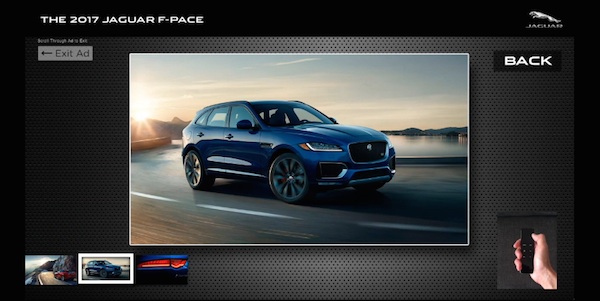Connect with execs from The New York Times, TIME, Dotdash Meredith and many more

The Washington Post has started running its first interactive ad on Apple TV. The ad, for Jaguar, consists of a 30-second commercial. The interactive part is that below the commercial are panels that the viewer can click on using their remote to see photo galleries of the inside and outside of Jaguar’s F-Pace.
The ad has been live for two weeks and the Post wouldn’t share engagement rates except to claim they’re higher than pre-rolls ads that run on websites.

“Our viewers haven’t seen this before,” said Anthony DeMaio, vp of global advertising for the Post. “There aren’t a lot of companies creating interactive ads in the marketplace.”
Old-fashioned TV viewing still dwarfs digital TV, but is projected to level off as people shift their attention from live TV to streaming on their desktops or connected TVs like Apple’s, according to eMarketer. Apple made it possible for media companies to publish to its Apple TV app store a year ago, and the Post uploads 20 videos a day there, representing the scope of its editorial coverage.
DeMaio wouldn’t say how many people have downloaded The Washington Post’s Apple TV app through which they can access Post videos, but maintained the audience on it is “growing steadily. We’re in the early days but as we move forward it will be an area of concentration for us.”
The Post used video ad firm Velocity Made Good to build the Jaguar ad, using VMG’s product called Avalanche. By being interactive, the idea is that they can give advertisers a way to gauge viewers’ interest in the product and command a premium price, even over regular preroll ads.
Whether people want interactive ads in the first place is still a question. There’s research showing that interactive video ads outperformed preroll ads on connected TVs. The Avalanche ad was built to stop running after 15 seconds if there’s no sign the viewer is engaging with it. This “escape hatch” should cap the annoyance factor, said Chris Batty, a former Gawker Media ad sales exec who founded VMG.
“The big question is, what do our readers think,” DeMaio acknowledged. “Is this something they’ll be interested in, or is this something that will be disruptive?” Not surprisingly, he said he’s confident the format will grow in importance as time goes on, based on the early results.
More in Media

Retail media meets publishing: News UK, Future and Ocado tap clean room tech for smarter data targeting
News UK, The Independent, Immediate Media and Future are teaming up with retail media network Ocado to test clean room-powered data matching.

From sidelines to spotlight: Esports events are putting creators center stage
Esports events’ embrace of content creators reflects advertisers’ changing priorities across both gaming and the wider culture. In the past, marketers viewed esports as one of the best ways to reach gamers. In 2025, brands are instead prioritizing creators in their outreach to audiences across demographics and interest areas, including gaming.

Condé Nast and Hearst strike Amazon AI licensing deals for Rufus
Condé Nast and Hearst have joined the New York Times in signing a licensing deal with Amazon for its AI-powered shopping assistant Rufus.





